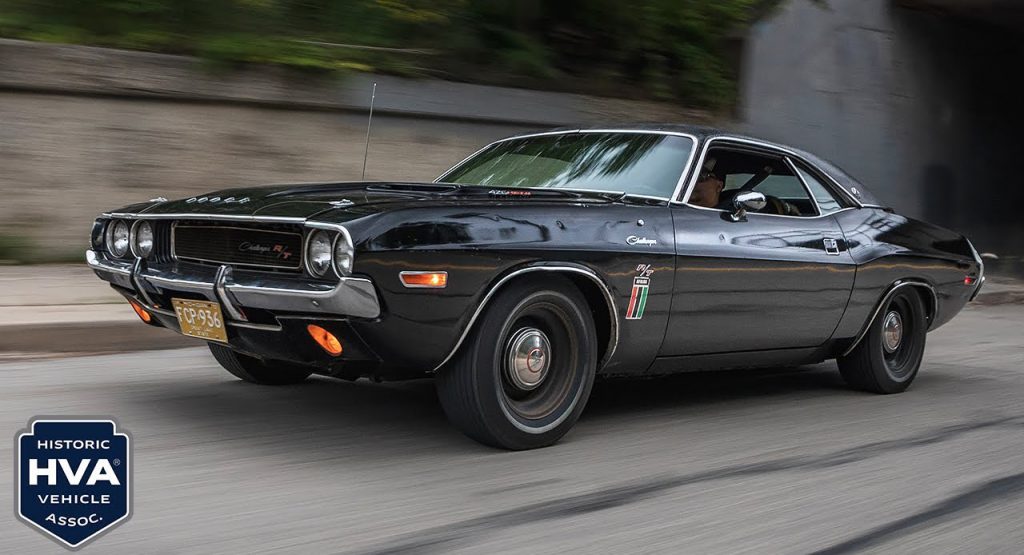The Black Ghost, a 1970 Dodge Challenger R/T SE, was a legendary car in the Detroit street racing scene. It was known to spontaneously appear, completely obliterate any competition it came across, then disappear without a trace.
It is easy to see why the car got it’s name, given its combo of black paint, black interior, and black Gator Grain vinyl top. However, that choice of interior was likely not readily apparent to most, as the Challenger swept in and out so quickly that you could never get a glimpse. It’s usual routine was to randomly appear, race and win, then disappear again for an indefinite period of time.
The Black Ghost activities were quite mysterious and secretive, and the details unknown to all but two men: Godfrey Qualls and his friend Curtis Neal. Qualls, the Challenger’s driver, was a Detroit police officer, which meant the duo had to keep their street racing antics a secret.
He also served in the military, as a paratrooper in the Army’s 82nd Airborne Division, receiving a Purple Heart after being injured by a grenade in the mid-1960s
See: 1970 Dodge Charger R/T Pink Panther Is Classic, Rare, And Up For Grabs
Qualls’ Black Ghost Challenger was special, to say the least. When be bought the car, he spec’d it with the R/T and Special Edition (SE) packages and the 426 engine, as well as the Super Track Pak, which came with a four-speed manual transmission and floor-mounted Hurst pistol grip, and added in a Sure-Grip Dana 60 with 4.10 gears.
On the aesthetic side, he optioned the car with hood pins, a houndstooth interior, and a “bumble bee” white stripe on the rear. The crowning touch was the black Gator Grain vinyl top, which actually was a mistake made by Dodge, as Qualls wanted plain black vinyl, but he decided to keep it anyway. There were only 23 Hemi four-speed R/T SE Challengers sold in the first model year, and Qualls’ car is likely the only car of its kind.
The Black Ghost quickly gained mythical status as its popularity spread. Soon, everyone was talking about it. People would pull up next to the car in hopes of racing, only to get beaten every time, after which the Black Ghost would disappear. Most of the time, it was Neal who was riding in the passenger seat with Qualls.
In an interview with Hagerty, Neal said “It was beating everything — Vettes, Chevelle 396, 37 … those were nothing for this car,” he said. “This car was the king of the street in those days.” Neal said they ran the drag races on Stucker Street, since it was an industrial area with no residential interference, and full quarter-mile races could be run where “police didn’t bother you.” This is pretty ironic, considering Qualls was a police officer. Neal’s rationale was interesting, saying it was a good way to keep those involved from engaging in other forms activities more risky or dangerous.
Read More: Low Mileage Dodge Challenger Demon Has Already Possessed Someone To Bid Way Over Sticker Price
Godfrey Qualls’ son, Gregory, apparently didn’t know anything about his father’s street racing until years later, although he was very aware of the car’s existence, with the following anecdote from Gregory as a testament.
“He taped a $100 bill to the dash and told me… ‘When I say go, if you can reach it, it’s yours,’”. Just as Gregory began to reach for the bill, his father hit the gas, and he was immediately pinned back against the seat. “I couldn’t get it… and I was scared. I remember that.”
What Gregory does know was the reason why his father stopped street racing. In 1977, Godfrey rejoined the military where he became a Green Beret, and while he was away, he left the Challenger dormant in the garage.
When he returned home three years later, he wanted to get the car up and running again. Upon asking a friend to look over the car, that friend, Herron, immediately recognized it as the Black Ghost after seeing it and hearing Qualls recall his time with it.
See Also: 1970 Dodge Challenger Restomod Is One Way To Spend $100,000
In 2014, Qualls’ son was over at his house, and told him he wanted to show him something in the garage. Godfrey pulled the wraps off the Challenger for full viewing. Gregory now says in hindsight that he didn’t know it at the time, but he thinks that it was his father’s way of letting him know he was sick. After his father had overcome prostate cancer in 2008, it had returned more aggressively. In 2015, shortly before the end of his life, Godfrey asked his son to grab an envelope at the house and bring it back to the hospital. What Gregory had brought back in the envelope was the car’s papers. Godfrey signed the title away to his son on the spot, but insisting that he never give it away.
Sadly, Godfrey Qualls passed away in 2015 on Christmas Eve. To this day, Gregory considers him as his hero. He also promises to heed his father’s words and keep the car in the family lineage, hopefully passing it on to his own son someday.
The story of the Black Ghost is a true all-American one, and the documentary that Hagerty and the Historic Vehicle Association have just produced about it is certainly worth your time. You can watch the whole thing for yourself below.



